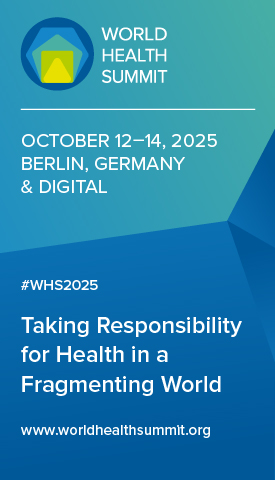Strengthening health and climate co-benefits
The Covid-19 pandemic has placed immense pressure on already struggling systems. The release valve lies in solidarity, global access and the shared understanding that health is a basic human right for everyone
Globalisation, reflected in economic activities and social relations, is rooted in industrialisation and urbanisation, which have advanced human health. However, other problems have emerged as a result of anthropogenic pressure and its profound impact on the biosphere. Climate change and biodiversity loss increase the vulnerability of humans, animals and plants to various health threats, including infectious diseases and antimicrobial resistance, as well as non-communicable diseases. Those effects exacerbate food and water insecurity and increase socioeconomic inequalities and health disparities.
Scientists, civil society, politicians, the private sector and others agree on the need to slow down and mitigate the catastrophic and existential threat posed by climate change. Evidence has shown the health and economic implications of activities in one part of the world (such as deforestation of the Amazon in South America and the Congo basin in Africa, coal mining in India, China and the United States, and vehicular and air traffic pollution in Asia, Europe and North America) on other parts of the world.
The effects on health can be direct, as shown by changes that increase the transmission of vector-borne infectious diseases among both humans and animals: the number of people at risk of contracting malaria will likely rise by 3% to 5% based on a 2–3°C increase in the average global temperature. Increased temperature worsens recurrent airway obstruction in horses. Changes to precipitation are associated with consequent extreme weather events such as droughts, floods and wildfires – which damage and limit access to infrastructure, including health systems, and aggravate health effects and hinder recovery from those effects. Air, water and soil pollution directly affects various life forms, the environment and climate through different complex mechanisms, which highlights the importance and benefits of One Health approaches to mitigating the health and climate change impacts of pollution.
The indirect effects of climate change on human, animal and environmental health can also be significantly severe, through ecological disruptions caused by climate change, loss of biodiversity, decreased crop yield and reduced availability of water. The economic impact of climate change and its resulting impact on health can also not be overstated.
A late awakening
Climate change and the pandemics have forced a rather late awakening that no one is safe until we are all safe. As such, investing in Health For All, while intrinsically altruistic, is an urgent requirement to preserve life on Earth. However, this ‘all’ has largely been limited to humans (and even then overlooks those in the lowest socioeconomic quintiles), neglecting the inextricable interconnections among humans, other animals, plants and our shared environment – the true ‘all’. One Health, encompassing all animals and the shared environment, becomes the most pragmatic and effective approach. With climate change the foremost global health and sustainability challenge of the 21st century, investing in Health For All using One Health approaches can strengthen health and climate co-benefits, because the linkages between climate and health are informed by our understanding of the complex socio-ecological systems in which humans, other animals and the environment are inextricably interconnected.
Low-income and middle-income countries are disproportionately affected by the deleterious effects of climate change and global health concerns, and by some mitigation policies. Health inequity (particularly poverty) increases exposure, sensitivity and susceptibility to pathogens and contaminants, and affects the capacity of populations to adapt to adverse environmental conditions. The impact of the Covid-19 pandemic on poverty declined among high- and middle-income countries, but worsened among the poorest countries. Efforts to curtail coal mining to cut emissions put countries such as India, with vast reserves and populations reliant on cheap coal-derived energy, at a serious disadvantage. Therefore, One Health approaches are desirable because they inherently include equity and sustainability considerations both in conducting research (including choice of populations, geographic locations and generalisability) and in designing interventions to strengthen climate–health co-benefits, particularly where resources are inadequate.
Bottom-up approaches
The choice to invest in health and climate co-benefits is political, and politics is influenced by the expressed desires of the populace. Bottom-up approaches to stimulating governments to invest in climate-resilient health systems are needed. The scientific community needs to work with civil society and grassroots organisations to foster national discourse and create awareness of climate–health interlinkages using One Health evidence – and the urgent need for action (including One Health investments). Once governments understand that their citizens view climate and health as a priority, it stimulates further discourse on One Health and investments, and motivates intergovernmental – and hence global – action as the effects of activities deleterious to climate and global health are often transnational. The severe droughts in the horn of Africa, parts of Europe and China, the flooding in Pakistan and the US, and the wildfires in Australia, Europe and North Africa are hardly the result of human activity limited to those specific geographic locations.
However, poor countries, which disproportionally bear the burden of the negative impacts of climate change and global health, often rely on international financing mechanisms. These funding schemes can constrain countries’ ability to finance climate change mitigation and health promotion. The recent establishment of the Financial Intermediary Fund by the World Bank, technically supported and staffed by the World Health Organization, is an important step. It will provide mainly low- and middle-income countries with direct financing and incentives for pandemic prevention, preparedness and response, including multi-sectoral One Health approaches. The FIF will also support integrated disease surveillance by enhancing data sharing, improving laboratory systems and their harmonisation, and supporting improvements in health workforce capacity, community engagement, essential medicines supply and distribution, and emergency communication. It would be a missed opportunity not to incorporate specific activities to strengthen health and climate co-benefits.
Global climate change governance is challenging, but could be facilitated by including climate-related issues into One Health governance structures, such as a permanent One Health body in the context of a pandemic accord or national and global One Health–related structures, in order to strengthen co-benefits. Such a body would provide technical and scientific support in the form of policy recommendations and guidelines, supporting and performing external evaluations, as well as capacity building for One Health approaches to implementing interventions that would yield climate and health co-benefits for all.












